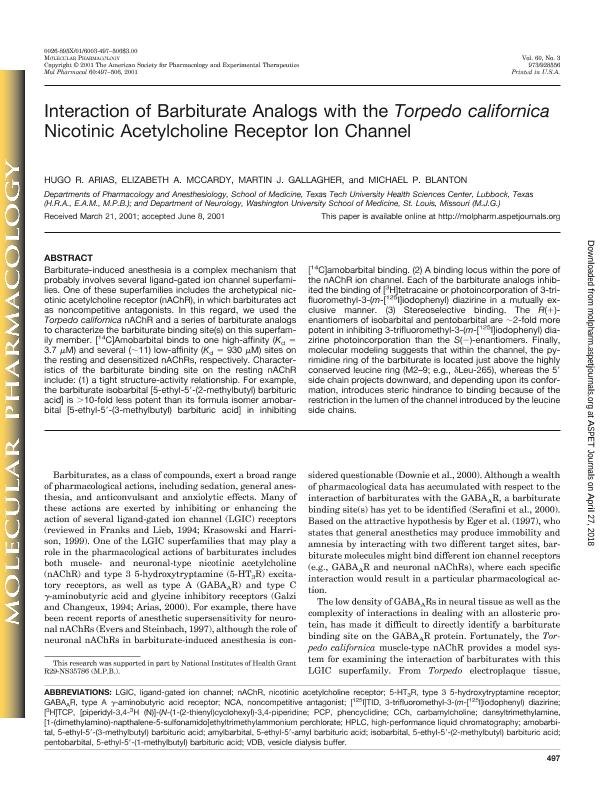Artículo
Interaction of Barbiturate Analogs with the Torpedo californica Nicotinic Acetylcholine Receptor Ion Channel
Fecha de publicación:
09/2001
Editorial:
American Society for Pharmacology and Experimental Therapeutics
Revista:
Molecular Pharmacology
ISSN:
0026-895X
Idioma:
Inglés
Tipo de recurso:
Artículo publicado
Clasificación temática:
Resumen
Barbiturate-induced anesthesia is a complex mechanism that probably involves several ligand-gated ion channel superfamilies. One of these superfamilies includes the archetypical nicotinic acetylcholine receptor (nAChR), in which barbiturates act as noncompetitive antagonists. In this regard, we used the Torpedo californica nAChR and a series of barbiturate analogs to characterize the barbiturate binding site(s) on this superfamily member. [14C]Amobarbital binds to one high-affinity (Kd = 3.7 μM) and several (∼11) low-affinity (Kd = 930 μM) sites on the resting and desensitized nAChRs, respectively. Characteristics of the barbiturate binding site on the resting nAChR include: (1) a tight structure-activity relationship. For example, the barbiturate isobarbital [5-ethyl-5′-(2-methylbutyl) barbituric acid] is >10-fold less potent than its formula isomer amobarbital [5-ethyl-5′-(3-methylbutyl) barbituric acid] in inhibiting [14C]amobarbital binding. (2) A binding locus within the pore of the nAChR ion channel. Each of the barbiturate analogs inhibited the binding of [3H]tetracaine or photoincorporation of 3-trifluoromethyl-3-(m-[125I]iodophenyl) diazirine in a mutually exclusive manner. (3) Stereoselective binding. The R(+)-enantiomers of isobarbital and pentobarbital are ∼2-fold more potent in inhibiting 3-trifluoromethyl-3-(m-[125I]iodophenyl) diazirine photoincorporation than the S(−)-enantiomers. Finally, molecular modeling suggests that within the channel, the pyrimidine ring of the barbiturate is located just above the highly conserved leucine ring (M2–9; e.g., δLeu-265), whereas the 5′ side chain projects downward, and depending upon its conformation, introduces steric hindrance to binding because of the restriction in the lumen of the channel introduced by the leucine side chains.
Archivos asociados
Licencia
Identificadores
Colecciones
Articulos(INMABB)
Articulos de INST.DE MATEMATICA BAHIA BLANCA (I)
Articulos de INST.DE MATEMATICA BAHIA BLANCA (I)
Citación
Arias, Hugo Rubén; McCardy, Elizabeth A.; Gallagher, Martín J.; Blanton, Michael P.; Interaction of Barbiturate Analogs with the Torpedo californica Nicotinic Acetylcholine Receptor Ion Channel; American Society for Pharmacology and Experimental Therapeutics; Molecular Pharmacology; 60; 3; 9-2001; 497-506
Compartir




